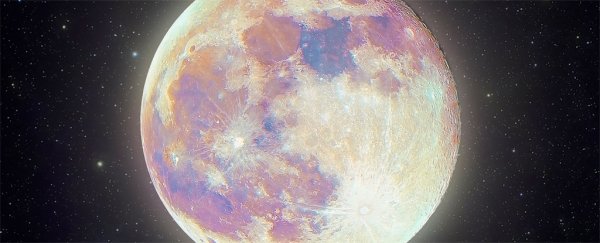It's been half a century since the Apollo missions returned from the Moon, and yet the lunar samples they brought home continue to baffle us.
Some of these rocks are more than 3 billion years old and appear to have been formed in the presence of a strong geomagnetic field, like the one on Earth. But the Moon today doesn't have a magnetosphere; it's too small and dense, frozen right through to the core.
Unlike Earth, the Moon's insides aren't constantly churning with electrically conductive material, which produces a geomagnetic field in the first place. So, why do lunar rocks tell us otherwise?
It's possible the Moon didn't freeze over as quickly as we thought; a few billion years ago, its core might have still been slightly molten.
But even if the field was sustained for a surprisingly long time, the strength of this field – given the Moon's size – is unlikely to match what the surface rocks are telling us.
Some scientists suggest the Moon used to wobble more, which kept the liquid in its belly sloshing away for slightly longer. Constant meteorites could have also given the Moon a boost in energy.
Researchers have previously entertained a new angle to the question, suggesting patches of the lunar surface were exposed to short bursts of intense magnetic activity.
In this latest study, a duo from Stanford and Brown University in the US has proposed a model describing just how these short-lived but powerful fields might form.
"[I]nstead of thinking about how to power a strong magnetic field continuously over billions of years, maybe there's a way to get a high-intensity field intermittently," explains planetary scientist Alexander Evans.
"Our model shows how that can happen, and it's consistent with what we know about the Moon's interior."
In the first billion years or so of the Moon's existence, its core was not much hotter than the mantle above. This meant the heat from the Moon's interior didn't have anywhere to dissipate, which is what usually causes molten material to move. The lighter, hotter bits tend to rise until they cool, while the denser, colder bits sink until they heat, and so on, and so forth.
Something else must have been stirring the pot, generating a magnetic field.
In its youth, an ocean of molten rock likely covered the Moon, and as the object cooled, this rock would have solidified at slightly different rates.
The densest minerals, such as olivine and pyroxene, would have sunk to the bottom and cooled first, while lighter elements like titanium would have floated to the top and cooled last.
Titanium-rich rock, however, would have weighed more than the solids below, causing chunks near the Moon's crust to drop through the mantle, right into the core.
Researchers think this sinking effect continued until at least 3.5 billion years ago, with at least a hundred blobs of titanium-rich material hitting 'rock bottom' in a billion years.
Each time one of these massive slabs, about 60 kilometers (37 miles) in radius, connected with the core, the mismatch in temperature would have temporarily reignited a surprising convection current, one strong enough to generate a strong pulse of magnetism.
"You can think of it a little bit like a drop of water hitting a hot skillet," says Evans.
"You have something really cold that touches the core, and suddenly a lot of heat can flux out. That causes churning in the core to increase, which gives you these intermittently strong magnetic fields."
The new models could help explain why different lunar rocks show different magnetic signatures. The Moon's magnetosphere may not have been a constant or consistent phenomenon.
The authors are now testing their explanation by looking back at lunar rocks to see if they can detect a weak magnetic background that is only occasionally pierced by a stronger force. The presence of a weaker magnetic hum would suggest a stronger magnetosphere was the exception and not the rule.
The study was published in Nature Astronomy.
